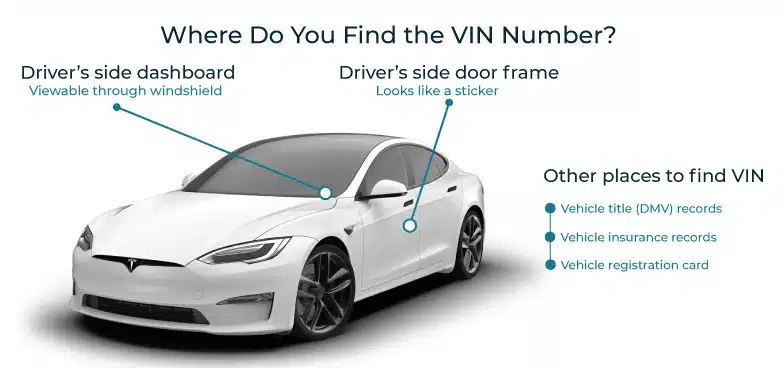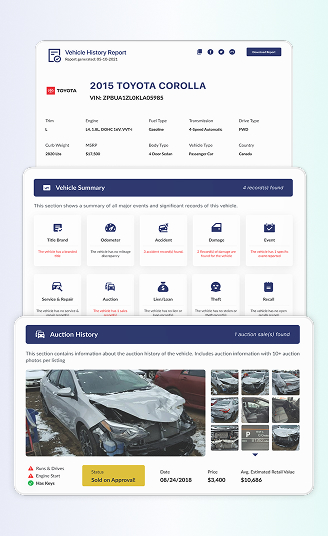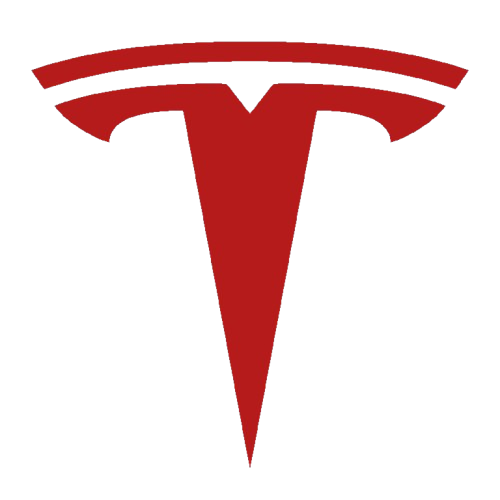
Tesla Recall Check
Stay safe with a Tesla Recall Check by Detailed Vehicle History. This powerful lookup tool shows you all active recalls for your Tesla using your VIN. Discover potential defects before they cause harm, save money on repairs!
What is a Tesla Recall?
Tesla is known as a leader in electric vehicles, but even good things sometimes go wrong. A Tesla Recall is issued when Tesla or regulators discover defects that could endanger drivers. For example, in 2025, many Teslas were recalled because the power steering assist failed after stops.
With a Tesla Recall Check, you can quickly see whether your car is among those affected and take action.
Why Should You Check the Tesla Recall History?
A Tesla Recall Check helps buyers avoid nasty surprises. Whether you’re eyeing a Model X, Model 3, Model Y, or any used Tesla, this quick lookup reveals safety recalls or defects.
Use it to confirm repairs have been done or ask the seller to fix them before you commit. Below are the details of why you should check the Tesla recall history:
Avoid Unsafe Tesla
Tesla recalls are warnings that something in the car could be unsafe. This might be a small issue or a serious risk that could harm drivers, passengers, or others on the road. A Tesla Recall Check lets you quickly confirm if repairs are needed, ensures they’re done for free, and keeps your vehicle safe to drive.
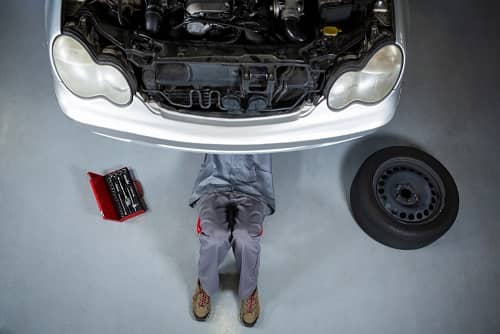
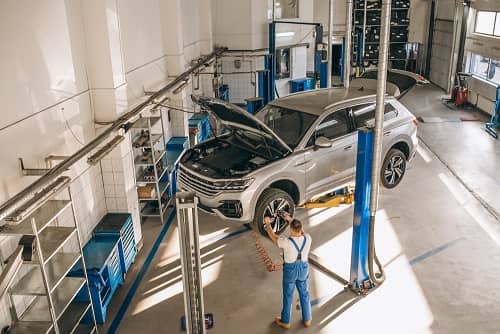
Compliance
Buying a Tesla with an open recall could mean the car isn’t meeting federal safety rules. This can create legal problems later, make resale harder, and even affect insurance.
Running a Tesla Recall Check ensures the vehicle is fixed for free, stays compliant with National Highway Traffic Safety Administration (NHTSA) standards, and protects both your safety and your investment.
Check Common Safety-Related Issues
Even the most advanced Tesla can have hidden problems. Some issues, like battery or steering defects, can put you at risk if not repaired. Checking your Tesla’s recall history is the easiest way to uncover these issues.
A Tesla Recall Check keeps you safe, protects your wallet from future repair costs, and gives you the peace of mind that your car is truly road-ready.

How to Run Tesla Recalls?
Get the Tesla recalls report in under a minute by following these simple steps below.

Locate Your Tesla VIN
You'll need your Vehicle Identification Number (VIN) handy. Find your Tesla VIN through touchscreen settings, windshield dashboard plate, or label inside the driver’s side door. Our lookup service works on any type of Tesla.
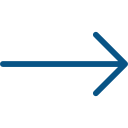

Fill in the Form
Enter your Tesla VIN in the form above to run a fast Tesla Recall Check. If you don’t have it, use your license plate number.


Receive Your Tesla Recall Report
Sit back for a few seconds while we generate your Tesla recall history. View results instantly and plan your next step.
What is on the Tesla Recall Check Report?
With Detailed Vehicle History, your recall report includes the recall date, the component or system affected, and clear next steps. Whatever the Tesla issue is, you’ll know what needs fixing. This helps protect your passengers, preserve resale value, and ensure your Tesla meets safety standards. See the breakdown below for more insight:
- Date of recalls: Tells you exactly when Tesla reported the problem, so you know whether it’s a new issue or one that’s been around for a while.
- Affected Component: Details the exact Tesla system or part that’s defective so you can understand what could fail and impact driving performance or safety.
- Consequences: Explains real-world risks like breakdowns, loss of control, or higher insurance costs if left unrepaired. Keeping you focused on protecting your Tesla investment.
- Next step for the affected Tesla: For affected Teslas, verify your recall status, schedule service, and get it fixed for free. Our detailed Vehicle History Report helps you track past recalls and repairs so you can keep your Tesla safe and compliant.
A Tesla vehicle history report also includes ownership history, auction records, mileage records, vehicle specifications, and more. For further insight, go through the breakdown below:
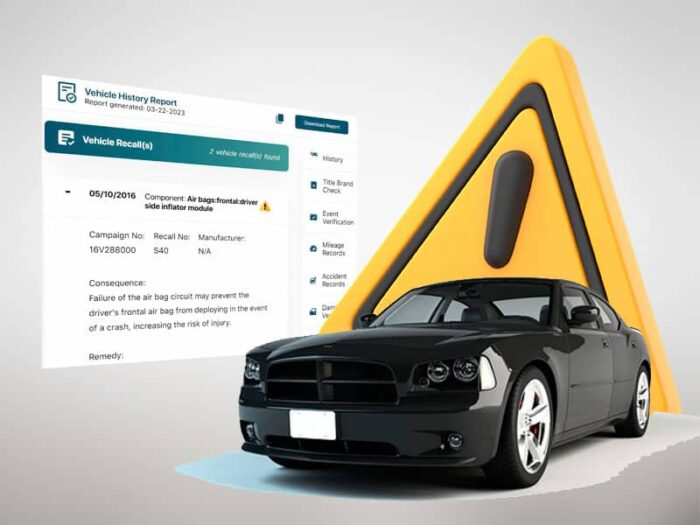
Ownership History
Learn about Tesla’s previous owners, their locations, and ownership lengths. Consistent, long-term ownership often means better vehicle care and fewer hidden issues.
Auction Records
See if your Tesla was ever sold at auction, the price it sold for, and its condition with photos. This helps you spot accidents, salvage titles, or hidden damage before buying.
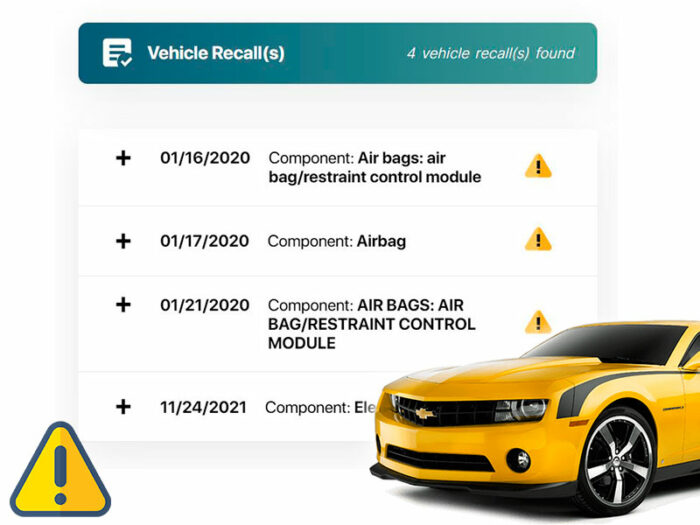

Mileage Records
Review your Tesla’s mileage history to confirm honest reporting. This section helps buyers avoid fraud, check normal wear patterns, and make smarter decisions about value and expected maintenance.
Vehicle Specifications
Verify your Tesla’s year, model, trim, and features to ensure they match the seller’s claims. This protects you from misleading ads and confirms you’re getting the exact Tesla you want.

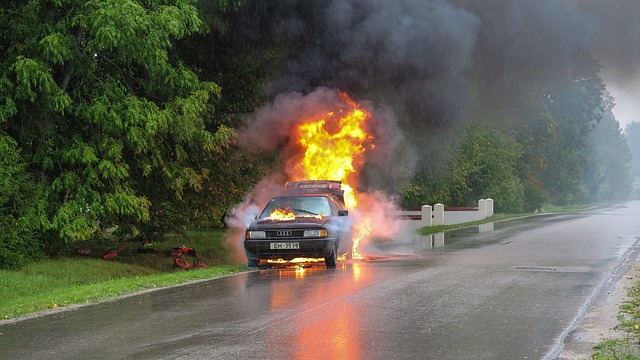
Accident and Damage Records
Check for any accident history or significant repairs. Our report shows severity, location, and damage type so you can make a safe, informed decision about your Tesla.
Title Brand Check
Find out if your Tesla was ever totaled, rebuilt, or damaged in a flood or fire. This transparency lets you buy confidently, knowing your vehicle has a clean history.
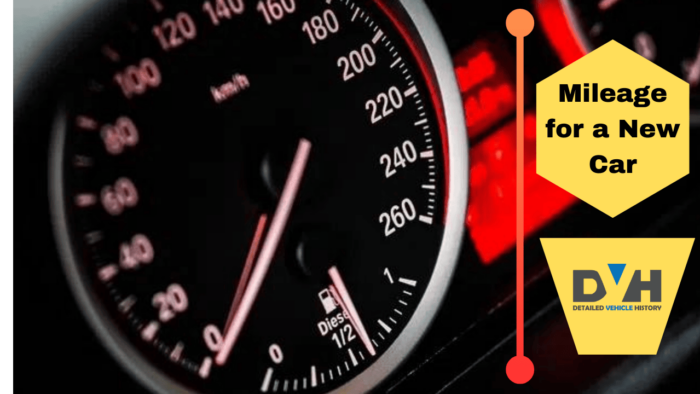
Common Issues Leading to Tesla Recall
Tesla recall notices exist to keep you safe. They typically involve: Autopilot behavior/monitoring, visibility and warning compliance, control systems like steering or brakes, occupant protection and seating, and additional concerns. Below are some of the causes behind the Tesla recall notices.
ADAS/Autopilot Monitoring & Behavior
Driver-monitoring limits
Driver-monitoring limits triggered a sweeping recall. In December 2023, Tesla updated Autopilot across around 2 million U.S. cars for Model S 2012–2023, X 2016–2023, 3 2017–2023, Y 2020–2023. In April 2024, NHTSA opened RQ24-009 to evaluate effectiveness.
Autosteer misuse safeguards
On Dec 12, 2023, Tesla recalled around 2.03M cars for Model S 2012–2023, Model X 2016–2023, Model 3 2017–2023, Model Y 2020–2023, because Autosteer could be misused. An over-the-air update added stronger driver-engagement checks, clearer alerts, and limits on where Autosteer works
FSD/OTA tuning
In February 2023, Tesla recalled 362,758 vehicles for Model S (2016–2023), Model X (2016–2023), Model 3 (2017–2023), and Model Y (2020–2023) due to Full Self-Driving (FSD) Beta could behave unsafely at intersections. An over-the-air (OTA) update tuned FSD/Autosteer with stronger rules.
Driver Information & Visibility Systems (HMI)
Tiny fonts and missing icons
Over 2.2 million Tesla vehicles were recalled in February 2024, including nearly all models sold in the U.S. from 2012–2024, due to tiny or missing icons on Tesla’s instrument panel. And the tiny font could make critical safety information difficult for a driver to read, increasing the risk of a crash.
Sounds that don’t play
In February 2022, Tesla recalled over 578,000 cars for Model 3 (2017–2022), Model S/X/Y (2020–2022), because the Boombox feature could mask the required Pedestrian Warning Sound (PWS) while moving, making cars too quiet for people nearby.
Wrong instructions
An official NHTSA recall with the ID 23V-838 was issued for Tesla vehicles in December 2023 due to “wrong instructions” or inadequate controls related to the Autosteer feature. Tesla issued a software update for over 2 million vehicles to address the problem.
Cameras, Sensors & Computers
The rear camera goes black
Rear camera failures have led to multiple Tesla recalls. The recalls occurred in January 2024, which affected over 199,000 Model S, Model X, and Model Y vehicles due to instability in the HW4 software.
Another recall took place in September 2024, involving over 27,000 Cybertrucks due to issues with delayed image processing.
Additionally, in January 2025, there was a recall for over 239,000 Model S, Model 3, Model X, and Model Y vehicles due to a risk of computer shorts. All issues were addressed through over-the-air (OTA) updates, and hardware was replaced when necessary.
Radar/ultrasonic glitches
Glitches in radar/ultrasonic interpretation can cause sudden braking without warning. The NHTSA has received reports from owners and started an investigation (PE22-002) in February 2022 for Model 3 and Model Y vehicles from 2021 to 2022.
Tesla previously issued an over-the-air (OTA) recall in November 2021 to fix false braking problems. In 2022, they began moving from radar and ultrasonic systems to Tesla Vision. You can check if your Tesla has received these updates by using the Tesla Recall Check.
The central computer resets or freezes
Tesla issued recalls in 2022 and 2025 due to central computer faults. The first recall in May 2022 affected certain 2021-2022 Model S, Model X, Model Y, and 2022 Model 3 vehicles, where the center computer could overheat during fast-charging, causing screen lag or blackout and hiding the rear camera view.
The second recall in January 2025 (25V-002) was due to a power-up short that could disable the rear camera. Solutions included over-the-air updates and necessary hardware swaps.
Steering, Braking & Stability
Loss of power steering assist
Two events prompted the Tesla recall story. In November 2022, Model S/X vehicles from 2017 to 2021 required Electronic Power Assisted Steering (EPAS) recalibration after hitting potholes.
Then, in February 2025, about 376,000 2023 Model 3/Y vehicles experienced assist loss following stops due to Printed Circuit Board (PCB) overstress. Over-the-air fixes were subsequently rolled out.
ABS/ESC faults
In January 2024, Tesla found the instrument-panel text for ABS/ESC and Brake warnings was too small, making safety alerts harder to see. Tesla fixed it with a software update that enlarges the required icons. Models affected span S, X, 3, Y, plus the 2024 Cybertruck.
Brake software calibration issues
The Model X’s controller used the wrong threshold for detecting low brake fluid. In October 2023, Tesla launched recall 23V-679 for 2021–2023 Model X and pushed a software fix so the dash alert shows up on time.
Other Notable Issues
Front Hood Latch
If the front hood (frunk) opens while driving, it can obstruct your view. On December 30, 2021, Tesla recalled certain Model S vehicles due to a misaligned secondary latch. Then, on July 30, 2024, a larger recall improved the hood-ajar detection system across multiple models using a software update.
Faulty Seat Belts Warning Systems
In May 2024, Tesla issued a recall for over 125,000 Model S, Model X, Model 3, and Model Y vehicles after discovering that the seat belt reminder might not audibly alert drivers at startup. A free over-the-air update is available to fix the calibration issue. It’s important to note that earlier belt-related campaigns, such as the hardware fastener fixes from 2021, were separate from this software problem.
Exterior Trim
In March 2025, Tesla recalled nearly all 2024–2025 Cybertrucks because exterior trim/body panels might not be secured well enough and could come off mid-drive. Tesla will inspect the panel, replace clips/adhesive as needed, and secure it at no cost. Run a Tesla Recall Check to confirm your VIN and remedy
Lateral Link Fastener Loosening
The issue is that the lateral-link bolts in the front suspension may not be tightened properly. This can cause the steering to wander or, in rare cases, lead to separation.
Tesla recalled Model 3 cars from 2019 to 2021 and Model Y cars from 2020 to 2021 in November 2021. They expanded this recall in December 2022 and April 2023 after service checks.
Remedies include inspection, re-torque, or part replacement.
Understanding the Tesla Recall Process
Your safety starts with reporting problems. When drivers report issues, NHTSA investigates carefully. If a safety defect is confirmed, Tesla must issue a recall and fix it for free. Here’s how it works
Report the Problem
If you believe your Tesla has a safety issue, file a complaint with NHTSA right away. Use their online “Report a Safety Problem” form or hotline. Complaints from people like you help spark investigations and can lead to recalls & free fixes.
Investigation
Each complaint is reviewed step by step, using data and inspections to determine if a recall should be issued.
- Screening: NHTSA reviews owner complaints and early-warning data to identify potential Tesla defects. If a risk is found, they start a Preliminary Evaluation, then an Engineering Analysis if needed.
- Analysis: In the Analysis phase, NHTSA verifies if a suspected Tesla defect poses a safety risk and conducts track evaluations.
- Investigate the Issues: When patterns appear, NHTSA investigates to confirm if Teslas are unsafe and require a recall.
- Recall Management: NHTSA oversees Tesla’s response, making sure owners are informed and defects are repaired to keep everyone safe.
Recalls
A Tesla recall is issued when a part or system is unsafe or doesn’t meet federal safety standards. Tesla must notify owners and provide a free fix. Most recalls are voluntary, but they are legally required to repair, replace, or refund affected vehicles. Protecting drivers, passengers, and everyone on the road.
How Tesla Vehicle Recalls Are Handled
A Tesla recall involves three players: Tesla, NHTSA, and you. Tesla identifies the defect and provides a solution, NHTSA ensures compliance, and you get the repair done at no cost. Together, these steps protect you, your passengers, and your Tesla’s performance and resale value.
Manufacturer’s Role
Tesla, as the manufacturer, must identify safety defects, notify NHTSA, and alert owners, then provide a free remedy (repair, replace, refund, or buyback). Tesla also supplies data so regulators can monitor completion. For owners, a quick Tesla Recall Check confirms status before scheduling service.
NHTSA’s Role
From screening complaints to demanding Tesla’s internal data, NHTSA ensures recalls aren’t ignored. It can force investigations, track repair rates, and even fine automakers who fail to cooperate. This independent oversight keeps Tesla accountable and helps make sure every recalled vehicle gets repaired.
Your Role as the Vehicle Owner
A recall isn’t complete until you take action. Use the Tesla recall check to confirm your status. Then arrange free repairs or allow the software update to install. Acting fast avoids accidents, maintains compliance, and ensures Tesla’s recall records stay accurate for every vehicle on the road.
Get Tesla Window Sticker by VIN
Go beyond a Tesla Recall Check and see your car’s full features with a Tesla window sticker. This official-style label reveals original specs, trim, colors, wheel options, factory-installed packages, battery range, safety equipment, and MSRP.
It’s the perfect way to verify authenticity, confirm features match the listing, and uncover missing or replaced parts. Whether you’re buying or selling, the window sticker gives you the confidence to negotiate a fair price and ensure your Tesla is exactly what it claims to be.
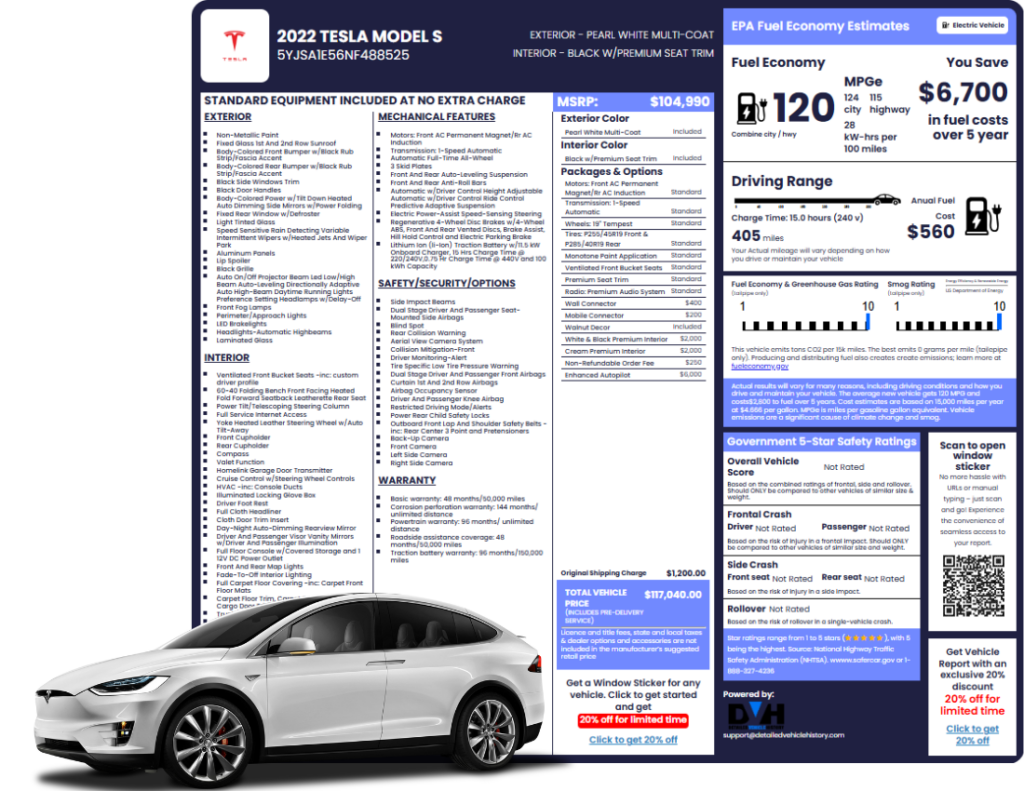
Why Use Detailed Vehicle History to Check Tesla Recall?
A Tesla Recall Check from Detailed Vehicle History reveals more than open defects. Each report shows recall dates, affected components, and remedies, along with title history, mileage logs, accident reports, and auction records when available.
This depth of insight protects your wallet, your safety, and your Tesla’s value. Before buying a used Tesla or continuing to drive, confirm everything with a detailed report that goes beyond the basics.
Recall Check For Others Manufacturers
FAQ about Tesla Recalls Check
Q. How do I know if my Tesla is recalled?
To check if your car has been recalled, use the Detailed Vehicle History Recall Lookup tool by entering your VIN. Tesla owners can find information on open recalls or safety-related service campaigns. For more details, contact your nearest Tesla service center or visit their website. If you’re buying a used car, ensure it isn’t affected by any recalls before payment.
Q. What are the most common Tesla recall issues?
Across models and years, Tesla recalls often address: Autopilot engagement/driver-attention rules, instrument-panel warning visibility, rear-view camera failures, electric power-steering loss, seat-belt reminders or fasteners, and front-hood latch or exterior-trim security. These patterns repeat over time, with OTA updates commonly used as the remedy.
Q. What happens if your Tesla is recalled?
If your Tesla is recalled, you’ll receive a notification and need to verify your vehicle using its VIN. Tesla will provide a free remedy, either via an OTA software update or a scheduled service visit. After the remedy, keep the service record for resale or insurance purposes.
When buying a used Tesla, check its recall history with the VIN or license plate using Tesla’s recall check. This will help you find any outstanding recalls and review important records like ownership history, vehicle specifications, and more.
Q. Do dealerships fix Tesla recalls for free?
Yes. Under U.S. law, manufacturers must fix safety recalls at no charge. For Tesla, work is handled at Tesla Service Centers (not traditional dealers) or via OTA updates when possible.
If you have already paid for the same issue, Tesla’s reimbursement plan may apply within the window.
Q. Do Tesla recalls expire?
A Tesla recall itself stays open in the record, but the no-charge remedy is guaranteed for up to 15 years from the first sale under U.S. law. After that, you may pay out of pocket.
Q. Can a dealer refuse to fix a Tesla recall?
Under U.S. law, Tesla recall services are free for up to 15 years. A dealer or service center cannot refuse a valid recall. However, they may place you on a waitlist if the necessary parts are not available or if the recall campaign has not yet begun.
If a service center refuses to assist you without a valid reason, be sure to note the date of the refusal, get it in writing, and escalate the issue to Tesla or the NHTSA.
Q. What happens if I missed a Tesla recall on my car?
Missed a Tesla recall? Don’t panic. Recalls don’t “expire,” and the free remedy is available for up to 15 years from the first retail sale.
Check your recall history using the Tesla recall check by Detailed Vehicle History, using your VIN or license plate, apply the OTA update, or book service, and file your paperwork. If you have already paid for the same defect, review Tesla’s reimbursement plan.

